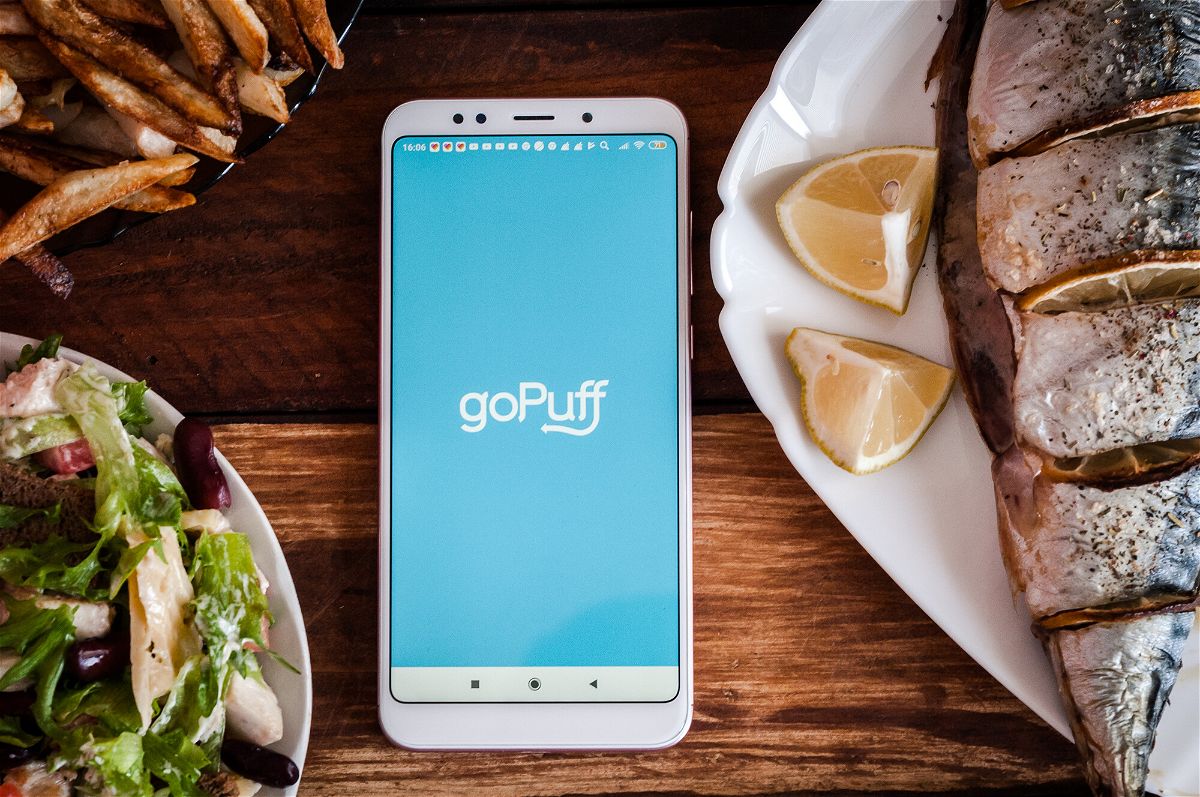This $15 billion startup promises 30-minute deliveries. Now it’s facing a worker backlash

Gopuff
By Sara Ashley O’Brien, CNN Business
Gopuff, a startup that originally launched to offer hookah deliveries for college students and later food deliveries to help satisfy the munchies, is rapidly establishing itself as the future of the on-demand industry.
The Philadelphia-based company has announced raising billions of dollars from investors to grow its on-demand delivery business this year alone amid a pandemic-driven boom for online shopping. But it’s also raising a familiar set of labor concerns in the process.
In an industry that prides itself on speed, Gopuff is one of several startups whose promise is being as close to instantaneous as possible. Better known services like DoorDash, Instacart and Uber Eats leverage fleets of drivers who pick up and deliver items from retailers and restaurants. Gopuff, on the other hand, has more than 450 micro-fulfillment centers in college towns and some major cities stocked with everything from food to over-the-counter medicine in order to better control the inventory and deliver products to customers within 30 minutes.
But Gopuff’s rapid growth, heavily fueled by venture capital, comes at a time when there is heightened attention to gig worker pay and benefits, or lack thereof, at both a federal and local level. Gopuff relies largely on the same controversial playbook as some of the larger on-demand companies in terms of how it works with delivery drivers. And in its push to fulfill deliveries in minutes instead of hours, Gopuff’s model may only exacerbate existing gig economy labor concerns.
Recently, some Gopuff delivery workers have taken issue with how they’re treated as independent contractors for the company, a classification that helps on-demand companies to cut costs by not obligating them to provide benefits like minimum wage, overtime, and unemployment insurance. These delivery companies typically defend this arrangement as allowing their workers more freedom to be their own boss, but some Gopuff workers have said they’ve experienced what they feel is a lack of independence.
In their day-to-day work, drivers say it feels as though they report to managers at Gopuff’s fulfillment centers — who are classified as employees by the company — rather than just dealing with the whims of an app, as is the case with other gig economy services. These managers control how many shifts to post to meet demand. Some workers said they communicate with managers using Slack and notify them when, for example, stopping for gas.
“As Gopuff drivers, we work on set shifts, have no ability to reject orders, and even report to managers who control almost every aspect of our work, from what jobs we get to whether we’re fired,” a group of workers said last month in an open letter done in collaboration with Working Washington, a Seattle-based workers’ rights organization. According to Working Washington, several hundred drivers have since signed on to the letter.
In response, Gopuff said fulfillment center managers do not have managerial authority over drivers. The company said workers have the choice for whether to secure shifts, which are eligible for minimum pay guarantees that can provide baseline earnings during slow periods, or to pick up delivery orders whenever they want, but without that pay guarantee. With the latter option, it’s unclear whether there would be enough work to make it worth their while given the company uses shift scheduling to meet demand.
On a FAQ page for drivers, Gopuff said it “highly suggests” drivers reserve scheduled shifts — which can be competitive to secure. When pressed by CNN Business for more information about how drivers are informed they can bypass signing up for shifts, Gopuff said it runs campaigns periodically to remind its drivers of different options and pointed to the FAQ page, which had been updated from earlier that day to remove the language recommending drivers secure shifts. When asked about this change, Gopuff said it is in the process of updating external resources for delivery partners.
“We recognize that as we grow, we must continue to improve our communications channels with delivery partners, and are actively working to enhance delivery partner communications, websites, customer support, and more,” said a Gopuff spokesperson in a statement provided to CNN Business.
The company also said it offers full-time and part-time employment opportunities, which come with benefits, inside its warehouses. Gopuff said it has more than 8,000 employees — including its corporate and warehouse employees. However, Gopuff declined to tell CNN Business how many independent contractors work as delivery drivers with the company.
Trying to make ends meet
Founded in 2013, GoPuff largely stayed under the radar until more recently when its valuation doubled and then nearly doubled again to $15 billion in less than a year. In recent months, Gopuff has scaled to more than 650 cities; acquired two international rivals, a US-based alcohol delivery startup, a liquor store chain and a fleet management startup; and secured a partnership with Uber. (The Uber deal is reportedly the subject of an investigation by the Federal Trade Commission into whether the agreement could hurt competition in online delivery of alcohol and convenience store items. Gopuff and the FTC declined to comment on it; Uber did not immediately respond to request for comment.)
Rafael Ilishayev, Gopuff’s co-CEO and cofounder, told CNBC in May that the company’s business model “is predicated on making margins on products, and really not making margins on people or the gig economy.” Because Gopuff buys products directly from suppliers, it then owns the inventory and can price it accordingly, making money off the sales. The company also has an advertising business for brands to market their products to customers.
But as with other gig economy firms, one of the biggest costs that Gopuff can control when offering expedited deliveries at affordable prices is how much it pays its workers, according to Gad Allon, a professor at University of Pennsylvania’s Wharton School of Business. “Ultimately, most of their costs are labor costs — labor for picking, labor for delivery,” said Allon.
In the letter, the workers are calling on the company to raise its hourly pay guarantee (which varies by location but in some places is as low as $8 per hour, the letter says) to ensure a living wage and cover basic expenses like vehicle mileage. (Gopuff said its minimum pay guarantees are at or above the local minimum wages in each market and that drivers earn $18 to $22 per hour on average across the US, including tips and other bonuses.) The workers are also calling for real flexibility and independence as well as more pay transparency, among other demands.
With the scheduled shifts, workers are eligible for a minimum hourly earnings guarantee, according to the company. That means Gopuff will subsidize their earnings to meet that threshold if they don’t hit it through commissions earned on each order, which range from $2.25 to $5.00, according to the company. But just as other gig companies have tweaked rates for workers over the years, Gopuff can choose to raise or slash its hourly earnings guarantee. According to Working Washington, workers at nearly 50 locations have recently reported having their hourly guarantees slashed. By its analysis, the average hourly subsidy cut was $3.96 per hour.
Gopuff said temporary subsidies were offered due to what it called operational changes. In a statement, the Gopuff spokesperson said that “given the fast moving nature of our industry, we will make adjustments to partner compensation to balance a continuously changing supply and demand dynamic in each market we serve,” calling it “industry standard.” (In addition to subsidies, Gopuff, like other gig companies, also offers workers promotions and incentives to boost earnings.)
“We will continue working to communicate any changes clearly, transparently and proactively to delivery partners,” the spokesperson said.
Bradleigh Aeh, a Gopuff delivery worker in Athens, Ohio who has been vocal about the work conditions, said she received a notification last week that a temporary increased subsidy that guaranteed she would make at least $12 per hour would be reduced to $9 this week. Despite Gopuff’s claim that minimum guarantees are at or above local minimum wages, prior to the temporary bump, the pay guarantee at Aeh’s location appeared to be below the local minimum wage of $8.80, according to Aeh and a screenshot reviewed by CNN Business. According to the Working Washington letter, at “some warehouses, the minimum guarantee is lower than local minimum wage,” an amount that is further lowered when factoring in how much workers spend on gas.
“I’ll try to make ends meet, which was still difficult with the $12 and will be even harder now,” Aeh said, noting it can be challenging to quickly secure free shifts before they’re swept up by others as the company adds new workers. “I could find another job in food service, or something … but I’d just be scraping by on minimum wage or close to it the same as I am now.”
Sage Wilson, an organizer with Working Washington, said Gopuff’s model feels familiar. “So much of it seems to be about shifting the cost of driving to workers,” Wilson said. “That’s one of the very expensive parts of doing delivery, and it’s a cost which in the short term can remain hidden from people doing the work until they get the big repair or run their car into the ground.”
According to Gopuff, there are unique benefits to its business that set it apart from other gig economy jobs, including that drivers deliver within a short radius of a micro-fulfillment center, resulting in less wear and tear on vehicles. It also said delivery partners can use the restroom at these fulfillment centers.
The-CNN-Wire
™ & © 2021 Cable News Network, Inc., a WarnerMedia Company. All rights reserved.



